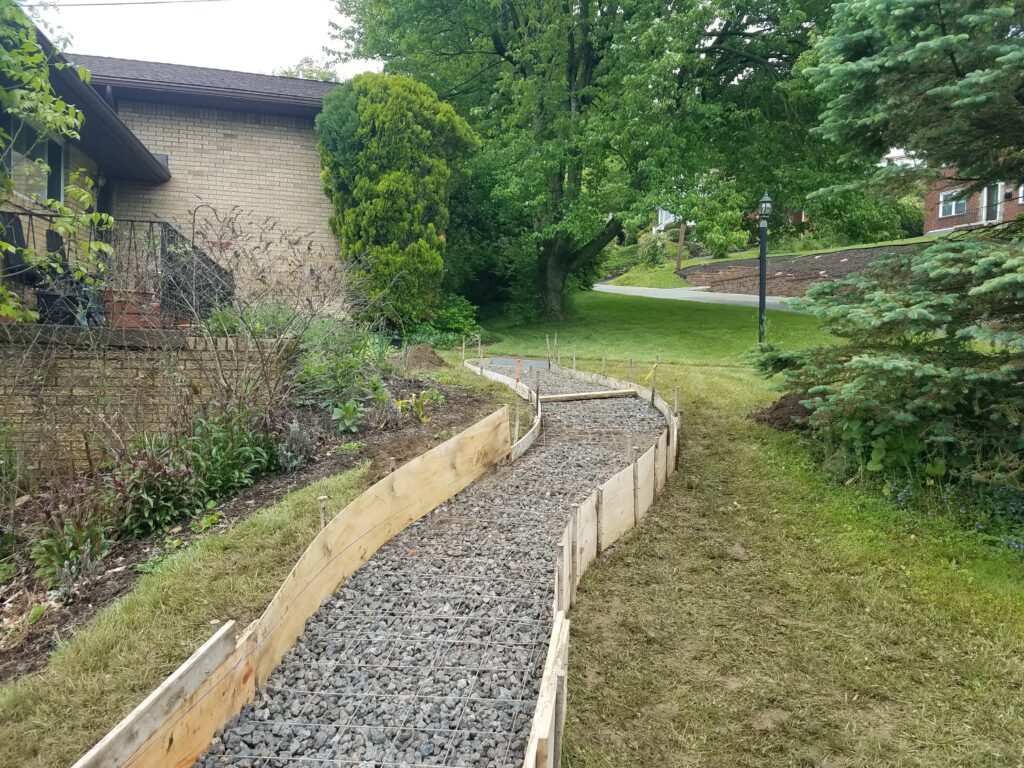As Pittsburgh yards go, ours is pretty flat, but there’s no such thing as having a completely flat yard in Pittsburgh. The chances of having your front, back/side, and garage doors all on the same level of the house are extremely low – in fact, ours are on three different levels, respectively. Our house was built in the 1950s, and in all that time, no one ever thought to install a set of outdoor steps from the driveway up to the front door. What that means is that we (and sometimes guests) have slipped down wet grass when traversing the steepest part of our property.
We finally decided to get some steps and a walkway added this year, partially as a convenience and partially as insurance against someone getting legitimately hurt. After getting a few estimates and vetting some contractors, we pulled the trigger this May. Of course, it also involved doing a little reading about concrete, which brings with it a massive carbon footprint, environmental degradation, and even political corruption. Given all of that, I wasn’t thrilled to be boasting a new concrete walkway, but, again, it did seem necessary from a safety standpoint.
Concrete Jungle
Concrete is the most widely used substance on Earth, after water. And it uses water in the production cycle – a lot of it, as a matter of fact. The basis of concrete is cement, which is made from limestone that is kilned at extremely high temperatures (2,700 degrees F), ground into a fine powder, and mixed with a few additives. Once mixed with water, cement is an incredibly strong binder. When mixed with sand, you get mortar; when mixed with aggregates, like small rocks, you get concrete.

Heating kilns to produce cement must largely be done with fossil fuels in order to reach the necessary temperatures. Some researchers are examining electrified kilns – and I recently heard about the possibility of using hydrogen fuel sources – but ultimately the prevalence of cement throughout the world and its carbon-intensive production process are why it is responsible for 8% of the world’s CO2 emissions.[1]
Massive concrete projects represent jobs and GDP growth – as was the case for the United States in the 1930s when we built the Hoover Dam.[2] It was the largest concrete project in the world at the time, but it has been eclipsed by others since then, with China’s Three Gorges Dam currently holding the title.[3] With China’s continued push for economic growth, the country currently uses half of the world’s concrete. Concrete represented a full third of their economy in 2017, and they are planning more projects domestically and beyond, notably in Kazakhstan, Brazil, and multiple countries in Africa.[4]
Environmental and Health Consequences
I went to college in New Jersey, which was nicknamed “the Concrete Jungle, but my experience was anything but. My school was nicknamed “the University in the Forest,” and it was just that: located on 186 acres of protected land, where building new structures – specifically “impervious surfaces” – was strictly limited. Removing natural ground cover and paving over it reduced the natural beauty of the campus and increased runoff, making it harder to manage rainwater. We see that in Pittsburgh all the time: the topography of the area plus the massive amount of paved surfaces means flood risks in low-lying areas and overflowing sewers when rainfall is high.[5]

In addition to the carbon footprint associated with the process, limestone quarries and cement plants create massive amounts of air pollution in the form of fine rock particles; diesel exhaust from trucks transporting the products also creates particulate matter, volatile organic compounds, and nitrogen oxides. All of these substances are harmful to the lungs of nearby residents. Meanwhile, the sheer amount of rock and sand needed for production has resulted in the flattening of mountains and the degradation of beaches and rivers, thereby decreasing the natural buffer zones that protect communities from flood waters and extreme weather events.
Increased demand for concrete has led to multinational companies dredging and mining for sand all over the globe, but particularly in southeast Asian island nations. According to a 2015 article from Wired, sand – plain sand – represented a $70 Billion industry, in light of massive development projects taking place all over the world. Not all operations are permitted and legal, however. There is such a demand for this commonplace – but finite – resource that communities in India resist illegal extraction on pain of death. [6]
Exploring Solutions
Over the next 40 years, newly built floor area in the world is expected to double. That level of development brings with it an increase in climate risks, health risks, and environmental injustices. It is difficult to imagine taking our collective foot off the gas, let alone tapping the brake on concrete production, especially considering the economic boon it is – at least in the short term. GDP growth tied to unnecessary development projects, such as unused malls and superhighways, looks concerningly like a bubble that must eventually burst.

In addition to recognizing that we should be using less concrete to begin with, some organizations are looking at ways to make the concrete we do use less impactful. MIT’s Concrete Sustainability Hub is looking at lower-carbon option options that either use unheated limestone as a component of the product or recapture CO2 emissions from the production process and incorporate it into the product.
The biggest hurdle of exploring new technologies is that no one wants to be the test case. Many development situations require specific components to be included in the concrete mixture, which result in certain performance attributes, rather than requiring specific performance attributes and being content-agnostic. MIT says that if construction codes and developer requirements can shift to focus on performance attributes instead of mixture contents, that will open the door for more innovative materials.[7]
I don’t know if low-carbon concrete is a viable option or just greenwashing, but I would have been interested in looking into our options (and prices) if a local contractor had been offering it. If you have any information on that front, please share in the comments below.
Thanks for reading!
[2] https://en.wikipedia.org/wiki/Hoover_Dam
[3] https://en.wikipedia.org/wiki/Three_Gorges_Dam
[4] https://www.theguardian.com/cities/2019/feb/25/concrete-the-most-destructive-material-on-earth
[6] https://www.wired.com/2015/03/illegal-sand-mining/
0 Comments